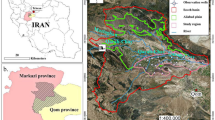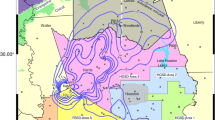Abstract
This article gives a general introduction to land subsidence with the prediction approaches due to withdrawal of groundwater in three subsided/subsiding regions in China: the deltaic plain of Yangtse River (YRDP), North China Plain (NCP), and Fenwei Plain (FP). On YRDP, Shanghai is the typical subsided/subsiding city; on NCP Tianjin is the typical subsided/subsiding city, and on FP Taiyuan is the typical subsided/subsiding city. The subsided area with subsidence over 200 mm on YRDP is about 10,000 km2 and the maximum subsided value reached 2.9 m at Shanghai; on NCP the subsided area reached 60,000 km2 with the maximum subsidence of 3.9 m at Tianjing; on FP the subsided area is relatively smaller than that on the other two plains and is about 1,135 km2 with maximum subsidence of 3.7 m at Taiyuan city. In order to protect the civil and industrial facilities, it is necessary to predict the future development of land subsidence based on present state. Many researchers proposed several approaches to predict the land subsidence due to groundwater withdrawal according to different geological conditions and groundwater withdrawal practice. This article classifies these approaches into five categories: (i) statistical methods; (ii) 1D numerical method; (iii) quasi-3D seepage model; (iv) 3D seepage model; (v) fully coupled 3D model. In China, the former four categories are presently employed in the prediction practice and their merits and demerits are discussed. According to the prediction practice, 3D seepage model is the best method presently.








Similar content being viewed by others
References
Biot MA (1941) General theory of three dimensional consolidation. J Appl Phys 12:155–164
Cassiani G, Palozzo W, Zoccatelli C (2002) Simulation of subsidence caused by gas production from an offshore field and comparison with field data. J Pet Sci Eng 45:123–134
CGS (China Geological Survey) (2006) http://www.cgs.gov.cn/TASK/shuigonghuan/shuiwen.htm (in Chinese)
Chai JC, Shen SL, Zhu HH, Zhang XL (2004) Land subsidence due to groundwater drawdown in Shanghai. Geotechnique 54(3):143–148
Chai J-C, Shen S-L, Zhu H-H, Zhang X-L (2005) 1D analysis of land subsidence in Shanghai. Lowland Technology International, International Association of Lowland Technology (IALT) 7(1):33–41
Chen CX, Cheng JM, Pei SP, Liu J (2005) Numerical model of land subsidence caused by groundwater abstraction and its countermeasure-by example of Suzhou City. Proc 7th Int Symp Land Subsidence (SISLOS 2005) 1:672–679
Chen J, Zhu GR, Gu AM, Wang CH (2003) Application of Biot consolidation theory to calculation of land subsidence. Hydrogeol Eng Geol 2:23–31 (in Chinese)
Chen SX, Wang CH, Liu SY, Nie BH (1994) Land subsidence of Hebei Plain. J Catastrophology 9(1):48–53 (in Chinese)
Gambolati G, Teatini P, Tomasi L (1999) Stress-strain analysis in productive gas/oil reservoirs. Int J Numer Anal Methods Geomech 23(13):1495–1519
Gong SL (2005) The geological environment and land subsidence protection of Yangtse River Delta. Proc 6th World Chin Symp Geol Sci 25–34 (in Chinese)
Gu XY (1998) Review and prospects of land subsidence computation. Chin J Geol Hazard Control 93(2):81–85 (in Chinese)
Gu XY, Ran QQ (2000) A 3-D coupled model with consideration of rheological properties. Proc 6th Int Symp Land Subsidence 1:355–365
Han JM (1998) Land subsidence and its counter measures of control in Shandong Province. Chin J Geol Hazard Control 9(2):33–35 (in Chinese)
He QC, Ye XB, Li ZM, Liu WB (2006) The status and prevention strategy of land subsidence in China. Geol J China Univ 12(2):161–168 (in Chinese)
He QC, Ye XB, Liu WB, Li ZM, Li C (2005) Land subsidence in the Northern China Plain (NCP). Proc 7th Int Symp Land Subsidence (SISLOS 2005) 1:18–29
Holzer T.L., Bluntzer R.L. (1984). Land subsidence near oil and gas fields, Houston, Texas. Ground Water 22(4):450–459
Hu RL, Yue ZQ, Wang LC, Wang SJ (2004) Review on current status and challenging issues of land subsidence in China. Eng Geol 76:65–77
IHEG (Institute of Hydrogeology and Engineering Geology), China Geology Bureau (1979) Hydrogeological Atalas of China. China Map Publisher, Beijing (in Chinese)
Li ML (2006) Mechanism and solutions of land subsidence on the plain areas of the southern part of Beijing-Tianjin on North China Plain. J Water Sci Technol Water Transfering Proj South-to-North Water 4(1):52–53 (in Chinese)
Li QF, Fang Z, Wang HM (2000) A mathematical model and forecast of groundwater workable reserves for Shanghai. Shanghai Geol 2:36–43 (in Chinese)
Li CJ, Tang XM, Ma TH (2006a) Land subsidence caused by groundwater exploitation in the Hangzhou-Jiaxing-Huzhou Plain, China. Hydrogeol J 14:1652–1665
Li QF, Wang HM (2006) A study on land subsidence in Shanghai. Geol J China Univ 12(2):169–178 (in Chinese)
Li SF, Ye XB, He QC, Fang H, She WF (2006b) A discussion on evaluation method of economical losing due to land subsidence hazard in North China Plain. Hydrogeol Eng Geol 4:114–116 (in Chinese)
Liu YH, Chen ZX, Ni WK (1994) A study on hazard-forming mechanisms of geofissures and land subsidence and control countermeasure in Xi’an. Chin J Geol Hazard Control 5(supp):67–74 (in Chinese)
Luo ZY, Liu W, Xia JZ (2005) Gray model prediction of land subsidence. Proc 7th Int Symp Land Subsidence (SISLOS 2005) 2:609–615
Ma T, Wang YX, Yan SL, Ma R, Yan CM, Zhou XP (2005) Causes of land subsidence in Taiyuan city, Shanxi, China. Proc 7th Int Symp Land Subsidence (SISLOS 2005) 1:102–110
Niu XJ, Ying YM, Bai JW, Ma F (2005) Secondary-consolidation deformation of soil and its effects on subsidence in Tianjin. Proc 7th Int Symp Land Subsidence (SISLOS 2005) 1:88–96
Pan GY, Zhong FP, Jiang YX (2006) Applying gray analytical method to identify groundwater-pumping-induced land subsidence. J Henan Polytech Univ 25(1):18–21 (in Chinese)
SGO (Shanghai Geology Office) (1976) Research report on land subsidence in Shanghai (in Chinese)
Shen SL, Tohno I, Nishigaki M, Miura N (2004) Land subsidence due to withdrawal of deep-groundwater. Lowland Technol Int 6(1):32–43
Shen SL, Xu YS, Cai ZY, Hayashi S (2006a) 3D-analysis on land subsidence in Shanghai due to withdrawal of groundwater. Proc Int Symp Lowland Technol (ISLT2006) 247–252
Shen SL, Xu YS, Hong ZS (2006b) Estimation of land subsidence based on groundwater flow model. Mar Georesources Geotechnol 24(2):149–167
Shen SL, Xu YS, Tang CP, Cai Z (2006c) A method to estimate the exploitable amount of groundwater based on the annual subsidence and annual withdrawn groundwater. China Intellectual Property Publishing House, Beijing (in Chinese)
Suo CM, Wang DQ, Liu ZZ (2005) Land fissures and subsidence prevention in Xi’an. Quaternary Sci 25(1):23–28 (in Chinese)
Wang HG (2006) Current situation and tendency of land subsidence in Tianjin. Master Dissertation. China Univ Geosci 26–32 (in Chinese)
Wang YP (2004) Study on land subsidence caused by overexploiting groundwater in Beijing. Site Invest Sci Technol 5:46–49 (in Chinese)
Wu TJ, Cui XD, Niu XJ, Chen WJ (1998) A study and prevention about land subsidence in Tianjin City. Hydrogeol Eng Geol 5:17–20 (in Chinese)
Xue YQ, Zhang Y, Ye SJ, Wu JC, Li QF (2005) Land subsidence in China. Environ Geol 48(6):713–720
Yin YP, Zhang ZC, Zhang KJ (2005) Land subsidence and countermeasures for its prevention in China. Chin J Geol Hazard Control 16(2):1–8 (in Chinese)
Yu J, Wang XM, Wu JQ, Xie JB (2006) Characteristics of land subsidence and its remedial proposal in Suzhou-Wuxi-Changzhou area. Geol J China Univ 12(2):179–184 (in Chinese)
Yu M (1994) The status and prevention strategy of land subsidence in Su-Xi-Chang area. Ground Water 16(4):178–181 (in Chinese)
Zhang X (2000) On establishment of Suzhou earth subsidence gray forecast model. J Suzhou Inst Urban Construct Environ Prot 13(4):53–57 (in Chinese)
Zhang Y (2002) One-dimensional model for land subsidence and its solution. J Eng Geol 10(4):434–437 (in Chinese)
Zhang YX (1998) Primary research on forecasting problem of time sequence in geotechnical engineering. Chin J Rock Mech Eng 17(5):552–558 (in Chinese)
Zhang AG, Wei ZX (2005) Prevention and cure with Shanghai land subsidence and city sustaining development. Proc 7th Int Symp Land Subsidence (SISLOS 2005), Shanghai, China 1:10–17
Zhang HM, Su BY, Xie YF (2004) Effects of water environment by over exploitation of groundwater in plain regions of Datong City. Territory Nat Resour Study 4:80–81 (in Chinese)
Zhang HP, Gu FJ, Guo RR (1998). The land subsidence and its countermeasures in Hebei Plain of China. Chin J Geol Hazard Control 9(supp):228–234 (in Chinese)
Zhang Y, Xue YQ, Wu JC, Ye SJ, Wei ZX, Li QF, Yu J (2006) Characteristics of aquifer system deformation in the Southern Yangtse Delta, China. Eng Geol 90(3–4):160–173
Zhao JK, Wu MJ, Liu SX (2004) Study on land subsidence and monitoring network in Hangjiahu Plain of Zhejiang Province. J Geol Hazards Environ Preserv 15(1):16–20 (in Chinese)
Zhu XB, Wu JC, Ye SJ, Zhao JK, Wu MJ (2005) The management model of groundwater resources in deep aquifers of the Yangtse Delta (South of the Yangtse River) consider the land subsidence. Proc 7th Int Symp Land Subsidence (SISLOS 2005) 2:647–653
Acknowledgement
This work is financially supported by the Open Research Foundation of Nanjing Hydraulic Research Institute (NHRI) (Contract No. YK90505).
Author information
Authors and Affiliations
Corresponding author
Rights and permissions
About this article
Cite this article
Xu, YS., Shen, SL., Cai, ZY. et al. The state of land subsidence and prediction approaches due to groundwater withdrawal in China. Nat Hazards 45, 123–135 (2008). https://doi.org/10.1007/s11069-007-9168-4
Received:
Accepted:
Published:
Issue Date:
DOI: https://doi.org/10.1007/s11069-007-9168-4




